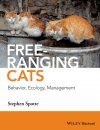Concise table of contents:
Preface xi
Abbreviations and symbols xvii
About the companion website xix
1 Dominance 1
2 Space 19
3 Interaction 49
4 Reproduction 72
5 Development 98
6 Emulative learning and play 116
7 Nutrition 137
8 Water balance and energy 158
9 Foraging 181
10 Management 214
References 251
Index 293
Detailed table of contents:
Preface xi
Abbreviations and symbols xvii
About the companion website xix
1 Dominance 1
1.1 Introduction 1
1.2 Dominance defined 1
1.3 Dominance status and dominance hierarchies 6
1.4 Dominance–submissive behavior 10
1.5 Dominance in free-ranging cats 15
2 Space 19
2.1 Introduction 19
2.2 Space defined 20
2.3 Diel activity 23
2.4 Dispersal 26
2.5 Inbreeding avoidance 27
2.6 Home-range boundaries 31
2.7 Determinants of home-range size 33
2.8 Habitat selection 41
2.9 Scent-marking 43
3 Interaction 49
3.1 Introduction 49
3.2 The asocial domestic cat 49
3.3 Solitary or social? 52
3.4 Cooperative or not? 58
3.5 The kinship dilemma 61
3.6 What it takes to be social 66
4 Reproduction 72
4.1 Introduction 72
4.2 Female reproductive biology 72
4.3 Male reproductive biology 84
4.4 The cat mating system: promiscuity or polygyny? 88
4.5 Female mating behavior 91
4.6 Male mating behavior 93
4.7 Female choice 96
5 Development 98
5.1 Introduction 98
5.2 Intrauterine development 98
5.3 Dens 100
5.4 Parturition 100
5.5 Early maturation 104
5.6 Nursing 108
5.7 Weaning 109
5.8 Survival 111
5.9 Effect of early weaning and separation 113
5.10 Early predatory behavior 114
6 Emulative learning and play 116
6.1 Introduction 116
6.2 Emulative learning 116
6.3 Play 121
6.4 Ontogenesis of play 125
6.5 What is play? 130
7 Nutrition 137
7.1 Introduction 137
7.2 Proximate composition 138
7.3 Proteins 139
7.4 Fats 148
7.5 Carbohydrates 150
7.6 Fiber 155
7.7 Vitamins 156
8 Water balance and energy 158
8.1 Introduction 158
8.2 Water balance 158
8.3 Energy 162
8.4 Energy needs of free-ranging cats 166
8.5 Energy costs of pregnancy and lactation 172
8.6 Obesity 178
9 Foraging 181
9.1 Introduction 181
9.2 Cats as predators 182
9.3 Scavenging 185
9.4 When cats hunt 189
9.5 Food intake of feral cats 189
9.6 How cats detect prey 190
9.7 How cats hunt 200
9.8 What cats hunt 205
9.9 Prey selection 207
9.10 The motivation to hunt 210
10 Management 214
10.1 Introduction 214
10.2 Effect of free-ranging cats on wildlife 215
10.3 Trap–neuter–release (TNR) 224
10.4 Biological control 233
10.5 Poisoning and other eradication methods 237
10.6 Integrated control 241
10.7 Preparation for eradication programs 245
10.8 “Secondary” prey management 247
References 251
Index 293



































